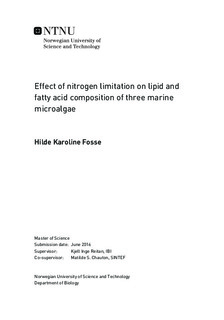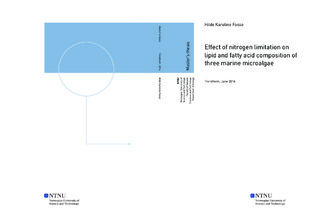| dc.description.abstract | The feed used in the aquaculture industry today uses mainly fish oil as lipid source, but this fish oil will be a limiting resource if the industry shall expand and meet the future demand of food to a growing world population. Lipids from marine microalgae can be a potential replacement of fish oil in feed used in the aquaculture industry. Marine microalgae species are a natural source of lipids, and important sources of the fatty acids eicosapentaenoic acid (EPA) and docosahexaenoic acid (DHA). If lipids from marine microalgae shall be a realistic potential replacement of fish oil in feed, the microalgae production costs has to be reduced. One way to reduce the production costs is to increase the biological productivity of the marine microalgae. Different cultivation conditions affects the productivity and biochemical composition of the marine microalgae, and this can be utilized to get desired results. Nitrogen limitation in growth medium under microalgae cultivation has in many studies shown an increased lipid content in microalgae cells, but the effect is highly species specific. In this study three marine microalgae (Phaeodactylum tricornutum, Rhodomonas baltica and Isochrysis aff. galbana T-ISO) were cultivated under nitrogen limited growth conditions, by two different cultivation methods, batch culture and semicontinuous culture. The different cultivation methods gave different level of nitrogen limitation, and from lipid and fatty acid analysis the content of lipid and fatty acids were detected to see how the nitrogen concentration in growth medium effected the biochemical composition. The productivity of the three microalgae species were also examined. All three microalgae species accumulated lipids under strong nitrogen limitation. The content of saturated fatty acids (SFA) and monounsaturated fatty acids (MUFA) had an overall increase, while the content of polyunsaturated fatty acids (PUFA) decreased with increased nitrogen limitation in the three microalgae species. The biomass, lipid and fatty acid productivity obtained in this experiment were generally lower than other studies have found. The productivity decreased in varying degree with extended nitrogen limitation | |

